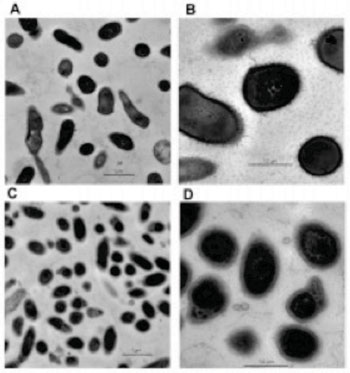Combined Resveratrol and Benzoyl Peroxide Treatment Effectively Kills Acne Bacteria
By LabMedica International staff writers
Posted on 15 Oct 2014
A combination of the common acne medication benzoyl peroxide and the anti-oxidant resveratrol was found to be more effective in eradicating the bacteria responsible for acne than was benzoyl peroxide alone.Posted on 15 Oct 2014
Acne vulgaris is a disease of the pilosebaceous unit (hair follicles and sebaceous glands), characterized by an inflammatory host immune response to the bacteria Propionibacterium acnes. Benzoyl peroxide is an oxidant that works by creating free radicals that kill the P. acnes bacteria.

Image: Microscope images of the bacteria P. acnes left untreated (A, B) or incubated for 24-hours (C, D) with resveratrol. Images were taken at 10,000 x magnification (A, C) or 29,000 x magnification (B, D) (Photo courtesy of the University of California, Los Angeles).
Resveratrol (3,5,4′-trihydroxystilbene) is an antioxidant that has multiple biologic effects including antimicrobial properties. The compound is found primarily in the skins of red grapes and is a component of Ko-jo-kon, a form of oriental medicine used to treat diseases of the blood vessels, heart, and liver. Red wine contains between 0.2 and 5.8 milligrams per liter of resveratrol, depending on the grape variety, while white wine has much less - the reason being that red wine is fermented with the skins, allowing the wine to absorb the resveratrol, whereas white wine is fermented after the skin has been removed. Resveratrol came to scientific attention during the mid-1990s as a possible explanation for the "French Paradox" - the low incidence of heart disease among the French, who eat a relatively high-fat diet. Since then, it has been promoted by manufacturers and examined by scientific researchers as an antioxidant, an anticancer agent, and a phytoestrogen.
Investigators at the University of California, Los Angeles (USA) sought to determine whether resveratrol may be a potential treatment for acne vulgaris. To this end they grew colonies of P. acne together with various concentrations of resveratrol and benzoyl peroxide both alone and together. Cultures were monitored for inhibition of bacterial growth for 10 days. In parallel, cultured human skin and blood cells were exposed to the two compounds to test for cytotoxicity. Colony-forming unit (CFU) assays together with transmission electron microscopy using P. acnes treated with resveratrol or benzoyl peroxide were used to assess antibacterial effects.
Results published in the September 17, 2014, online edition of the journal Dermatology and Therapy revealed that resveratrol demonstrated sustained antibacterial activity against P. acnes, whereas benzoyl peroxide demonstrated a short-term bactericidal response. A combination of resveratrol and benzoyl peroxide showed high initial antibacterial activity and sustained bacterial growth inhibition. Electron microscopy of P. acnes treated with resveratrol revealed altered bacterial morphology, with loss of membrane definition and loss of well-defined extracellular fringe-like structures. Exposure of human skin and blood cells to the compounds showed that resveratrol was less cytotoxic than benzoyl peroxide.
“We initially thought that since actions of the two compounds are opposing, the combination should cancel the other out, but they did not,” said first author Dr. Emma Taylor, assistant clinical professor of dermatological medicine at the University of California, Los Angeles. “This study demonstrates that combining an oxidant and an antioxidant may enhance each other and help sustain bacteria-fighting activity over a longer period of time. We hope that our findings lead to a new class of acne therapies that center on antioxidants such as resveratrol.”
Related Links:
University of California, Los Angeles














